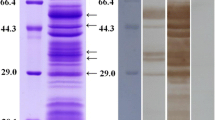Abstract
Clonorchis sinensis excretory–secretory (ES) antigens were separated by gradient SDS-PAGE and the antigenic protein isolated at 21 kDa was injected into rats. A C. sinensis cDNA library was then immunoscreened with sera from the 21-kDa antigenic protein-immunized rats. The selected genes, which were named C. sinensis myoglobin, contained a single open reading frame of 450 base pairs encoding 150 amino acids. A single hybridized band of 0.57 kb and two to four hybridized bands were detected by Northern and Southern blotting. Purified recombinant C. sinensis myoglobin was recognized by clonorchiasic rabbit sera (50%) and clonorchiasic human sera (25%). An indirect immunofluorescence assay showed that C. sinensis myoglobin is distributed over the whole body of the adult worm. It is believed that the abundance of C. sinensis myoglobin plays an important role as an oxygen reservoir under anaerobic conditions.







Similar content being viewed by others
References
Carnevale S, Rodriguez MI, Santillan G, Labbe JH, Cabrera MG, Bellegarde EJ, Velasquez JN, Trgovcic JE, Guarnera EA (2001) Immunodiagnosis of human fascioliasis by an enzyme-linked immunosorbent assay (ELISA) and a micro-ELISA. Clin Diagn Lab Immunol 8:174–177
Carpenter HA (1998) Bacterial and parasitic cholangitis. Mayo Clin Proc 73:473–478
Cervi L, Rossi G, Masih DT (1999) Potential role for excretory–secretory forms of glutathione-s-transferase (GST) in Fasciola hepatica. Parasitology 119:627–633
Chung YY, Ko RC (1999) A novel cDNA clone encoding a specific excretory/secretory antigen of larval Trichinella pseudospiralis. Parasitol Res 85:685–691
D′Souza PE, Hafeez M (1999) Detection of Taenia solium cysticercosis in pigs by ELISA with an excretory-secretory antigen. Vet Res Commun 23:293–298
Kiger L, Rashid AK, Griffon N, Haque M, Moens L, Gibson QH, Poyart C, Marden MC (1998) Trematode hemoglobins show exceptionally high oxygen affinity. Biophys J 75:990–998
Kim SH, Park YN, Yoon DS, Lee SJ, Yu JS, Noh TW (2000) Composite neuroendocrine and adenocarcinoma of the common bile duct associated with Clonorchis sinensis: a case report. Hepatogastroenterology 47:942–944
Kim SI (1994) Immune reactions between excretory-secretory antigens and specific antibodies of Clonorchis sinensis before and after praziquantel treatment in experimentally infected rabbits. Korean J Parasitol 32:35–42
Kim SI (1998) A Clonorchis sinensis-specific antigen that detects active human clonorchiasis. Korean J Parasitol 36:37–45
Lim JH (1990) Radiologic findings of clonorchiasis. Am J Roentgenol 155:1001–1008
Liu LX, Harinasuta KT (1996) Liver and intestinal flukes. Gastroenterol Clin North Am 25:627–636
Mehta VK, Lohar H, Banerjee GK, Reddy MV, Harinath BC (1999) Surgical filariasis: immunoscreening for filarial IgG antibodies using Wuchereria bancrofti microfilarial excretory–secretory antigen. J Commun Dis 31:35–40
MHW/KAH (1997) Prevalence of intestinal parasitic infections in Korea—the sixth report. Ministry of Health and Welfare/Korea Association of Health, Seoul, Republic of Korea
Preuksaraj S (1984) Public health aspects of opisthorchiasis in Thailand. Arzneimittelforschung 34:1119–1120
Rashid KA, Haque M, Siddiqi AH, Stern MS, Sharma PK, Vinogradov SN, Walz DA (1993) Purification and properties of the hemoglobins of the platyhelminth Isoparorchis hypselobagri (Trematoda: Isoparorchidae) and its host Wallagu attu (catfish). Comp Biochem Physiol B Biochem Mol Biol 106:993–998
Rashid KA, Haque M, Siddiqi AH (1995) Structural and functional comparison of trematode haemoglobins. J Helminthol 69:65–68
Rashid AK, Van Hauwaert ML, Haque M, Siddiqi AH, Lasters I, De Maeyer M, Griffon N, Marden MC, Dewilde S, Clauwaert J, Vinogradov SN, Moens L (1997) Trematode myoglobins, functional molecules with a distal tyrosine. J Biol Chem 272:2992–2999
Rim HJ (1990) Clonorchiasis in Korea. Kisaengchunghak Chapchi 28[Suppl]:63–78
Sadjjadi SM, Khosravi M, Mehrabani D, Orya A (2000) Seroprevalence of toxocara infection in school children in Shiraz, southern Iran. J Trop Pediatr 46:327–330
Sanger F, Nicklen S, Coulson AR (1977) DNA sequencing with chain-terminating inhibitors. Proc Natl Acad Sci USA 74:5463–5467
Santra A, Chowdhury A, Ghosh A, Mazumder DN (2000) Development of an animal model of hepatic fibrosis by excretory-secretory antigen of Ascaris suum. Indian J Gastroenterol 19:119–121
Yamasaki H, Araki K, Lim PK, Zasmy N, Mak JW, Taib R, Aoki T (2000) Development of a highly specific recombinant Toxocara canis second-stage larva excretory-secretory antigen for immunodiagnosis of human toxocariasis. J Clin Microbiol 38:1409–1413
Yong TS, Yang HJ, Park SJ, Kim TK, Lee DH, Lee SM (1998) Immunodiagnosis of clonorchiasis using a recombinant antigen. Korean J Parasitol 36:183–190
Acknowledgement
This work was supported by the BK21 project for Medical Science, Yonsei University.
Author information
Authors and Affiliations
Corresponding author
Rights and permissions
About this article
Cite this article
Sim, S., Park, GM. & Yong, TS. Cloning and characterization of Clonorchis sinensis myoglobin using immune sera against excretory–secretory antigens. Parasitol Res 91, 338–343 (2003). https://doi.org/10.1007/s00436-003-0869-7
Received:
Accepted:
Published:
Issue Date:
DOI: https://doi.org/10.1007/s00436-003-0869-7




